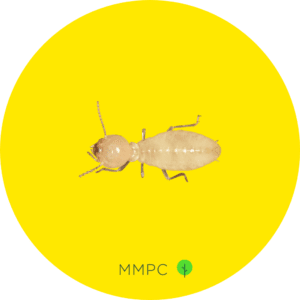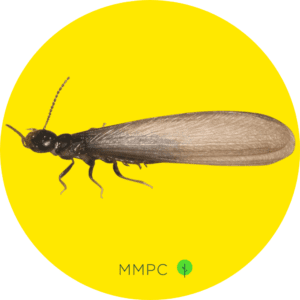
How do you know if you have termites in your home or property?
Termite season in New York usually starts to peak in the spring, when swarms of these wood-destroying insects start to emerge from their colonies in search of mates and new places to build nests.
As a homeowner or landlord, it’s important to understand the early warning signs of termites, such as mud tubes and discarded swarmer wings. Recognizing a termite problem before it gets out of hand might save you thousands of dollars in repair and extermination costs.
In this article, we’ll discuss the most common early signs of termites to look out for in order to protect yourself from these destructive pests.
How Can You Tell if You Have Termites?
In New York and the Northeast, the most common type of termite is the Eastern subterranean termite. These species are known to swarm during the spring and summer months.
Compared to drywood termites, subterranean termites are more difficult to detect because they typically live underground (rather than inside wood). We’ll be focusing mainly on subterranean termites for this article, but some of the signs below apply to drywood termites as well.
To know if you have termites, keep an eye out for the 5 warning signs we’ve listed below. In addition to staying vigilant, we recommend scheduling annual inspections to help detect termite activity before they cause significant damage to your home or property.
Here are 5 early signs of a potential termite infestation to look out for:
5 Signs of a Termite Infestation

1. Stuck Windows or Doors
Do you have a window or door that recently feels stuck, or suddenly became much harder to open or close? This can sometimes be an early warning sign of an termite infestation.
Termites tend to target locations like windows and doorframes, where wood is exposed and easy to access. As termites begin to eat through the wood, it may cause your windows and door frames to warp, making it difficult to open or close them properly.
Besides stuck windows or doors, damage from termites may also result in other types of structural problems in your home, such as crumbling baseboards or sagging floors and ceilings.
Structural problems may have other causes (for example, wood rot or seasonal changes in humidity) so look closely for damaged wood with termites or tunnels containing dried dirt to determine if you really have termites.

2. Damage under Paint or Wallpaper
Termites leave behind tiny pin holes (called exit holes) while feeding on cardboard and wood paneling underneath the surface of your walls.
Sometimes they do this without disturbing the thin coat of paint or wallpaper on the surface, which makes this type of damage difficult to detect unless the paint or wallpaper is removed. That’s why people are more likely to discover termite damage during home repairs and renovations.
An unusual appearance on painted or wallpapered surfaces can also be an early sign of termites. If you look carefully, you can see signs of termite damage underneath, such as:
- Small pinholes where termites have eaten through
- Bubbling paint
- Peeling or discolored wallpaper
- Buckling wood
- Dented or sunken areas
- Narrow, sunken winding lines

3. Termite Swarmers & Discarded Wings
Seeing termite swarmers inside a house or building is a telltale sign of an active termite infestation.
Termites have a caste system that consists of workers, soldiers, and swarmers. Termite swarmers, also known as alates, are the reproductive members of a termite colony.
They’re easily distinguishable by having two pairs of large wings, which are pale-colored and approximately 1/4–1/2 inches long. After a swarmer leaves the colony and finds a mate, it sheds its wings.
In New York, you’ll most likely see termite swarmers flying about in the early spring, when they emerge to find mates and establish new colonies.
Since swarmers are attracted to light, they tend to be around doors and windows. They also don’t live very long indoors, so you might find dead swarmers or discarded wings near windowsills and entryways.
People often mistake swarmers for flying ants. They look very similar, but termite swarmers have straighter bodies and two evenly-sized pairs of wings, whereas flying ants have pinched waists and two unevenly-sized pairs of wings.

4. Mud Tubes
Next, check your property for mud tubes. Mud tubes look like narrow veins along the side of your home. These tubes start from the ground and tend to run towards areas with exposed wood.
Termites use mud tubes to protect themselves from dryness in the air. Subterranean termites, which are the most common type of termites in New York City, have thin exoskeletons and will dry out very quickly. Mud tubes allow them to safely travel from their colony to their food source.
If you find mud tubes, you can confirm if you have an active termite infestation by breaking off a piece of the mud tube and checking for live termites. Even if you don’t find any at first, come back later to check if the tube has been repaired.
If you don’t find any signs of live termites, and the mud tube is not repaired, it still doesn’t mean that you’re in the clear. The termites may have moved to another part of your home or property with better access to their food source.

5. Termite Droppings
Termite droppings, also known as “frass,” is another sign of termite activity. As termites eat through the wood, they digest it and push it out of the colony to avoid buildup.
Only frass from drywood termites, which are found primarily in southern coastal states, is visible outside of termite galleries. Drywood termite frass is wood-colored and pellet-shaped, often appearing like wood dust or shavings.
In comparison, subterranean termites use their droppings to build their mud tunnels. If you live in New York City or the northeast, you most likely won’t encounter any drywood termite frass.
MMPC: Eco-Friendly Termite Control in NYC
Termite treatments should be carefully administered by licensed professionals in order to achieve effective results. MMPC has over 25 years of experience as one of the best termite control experts in New York and New Jersey.
Warning signs of termites shouldn’t be taken lightly, because these pests are capable of causing serious and costly damage to your home. Termite colonies take between 3–5 years to mature, which means that termite damage can accumulate over a long period of time.
We highly recommend scheduling annual inspections to detect and treat infestations early.
At MMPC, we believe that no two cases are the same, and we always strive to provide every client with the customized and guaranteed termite solutions. If you’ve discovered signs of termites in your home or property, contact MMPC today for a free quote.
Free Pest ID Service
If you’ve found something that looks like it might be a termite or a termite swarmer, send a picture to our Free Pest ID Center and our termite experts will be happy to help identify it for you.


